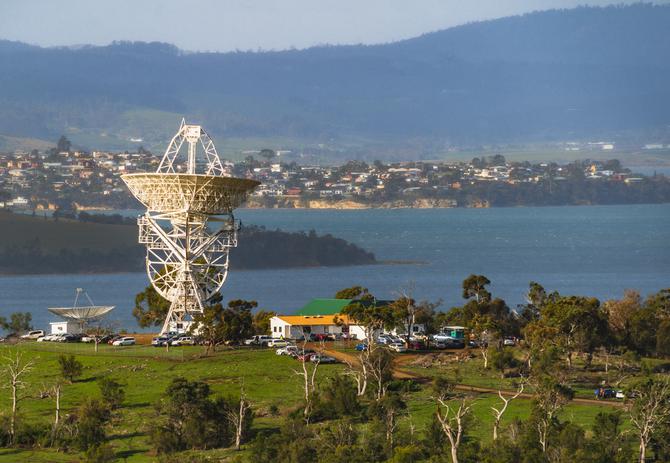Tasmania is poised to play a significant role in the exploration of our solar system and the Milky Way, with the expansion of the University of Tasmania's space tracking capabilities and the upgrading of its optical observatory.
A forthcoming European Space Agency mission to explore Jupiter and three of its icy moons will involve researchers, students and technical staff from the University's School of Natural Sciences.
They also took part, in February, with Dutch radio astronomers in the tracking of NASA's Mars Insight lander, which since its touchdown in November 2018 has been exploring the Red Planet's 'inner space' - its crust, mantle and core.
The expansion of the University's tracking facilities is the result of an agreement between the University and the Australian Space Agency, formalised last November.
"This MoU builds on a long and rich history of University of Tasmania involvement in international space missions," Professor Simon Ellingsen, Acting Dean of the School of Natural Sciences, explains.
"With this Australian Space Agency-funded upgrade, we are looking forward to playing an even bigger role in the future supporting both Australian-led and international projects."
A remote area logistics expert, Daleen Koch, started today (Monday, 25 May, 2020) as project manager for the expansion program.
Antennae installation
The upgrade will involve the installation of two antennas at the University's Greenhill Observatory at Bisdee Tier, 70 kilometres north of Hobart. It is one of five observatories operated by UTAS, the others being radio telescopes at Cambridge, Ceduna in South Australia, Yarragadee in Western Australia, and Katherine in Northern Territory.
A 7m antenna will provide support for a broad range of satellites and operations. A second, 2-3m dish, will support Australian-made nanosatellites.
"We expect to announce the signing of a contract with a manufacturer of antennae within a matter of weeks," Professor Ellingsen said. "The schedule of installation is uncertain with the current COVID-19 lockdown, but we expect to install the antennae later this year."
The Greenhill Observatory is home to a 1.3 metre optical telescope and boasts onsite accommodation from visiting astronomers (travel restrictions permitting). It was one of four telescopes – the only one in the Southern Hemisphere – used by an international research team recently to map the magnetic fields in space within about 150 light-years of the Sun.
One of the largest in Australia outside of the Siding Spring Observatory in NSW, Greenhill was commissioned in 2013 and has since contributed to studies of Pluto's atmosphere and the discovery of Earth-like planets around other stars.
New lightweight mirror
The telescope's original primary mirror is currently being replaced after School of Natural Sciences discovered an optical flaw that prevented it from being used to its full sensitivity.
The new mirror was created using an experimental manufacturing technique. It is supported on glass posts, with many gaps for airflow and weight reduction.
"The rejuvenated telescope will soon be ready for another season of searching for exoplanets and monitoring the sky for powerful stellar explosions," Associate Professor Andrew Cole said.

Mt Pleasant Observatory, Cambridge - one of the University's four radio telescopes.
JUICE mission
The part to be played by Tasmania in the European Space Agency's JUpiter ICy moons Explorer (JUICE) mission, scheduled for launch in mid-2022, was reinforced during a pre-lockdown visit by Professor Leonid Gurvits from The Netherlands-based Joint Institute for VLBI Europe, a major research infrastructure consortium.
Professor Gurvits is the Principal Investigator of PRIDE, the Planetary and Radio Interferometry and Doppler Experiment, a scientific instrument that will be onboard JUICE. The former uses ground-based radio telescopes such as that at Mt Pleasant operated by UTAS to precisely determine the position and velocities of any deep space mission.
In addition to formal discussions to strengthen the collaboration between the mission planners and the University, Professor Gurvits hosted an inspiring colloquium for the young generation of physics students.
Mars Insight lander
Dr Guifré Molera Calvés is leading the University's spacecraft-tracking activities. In February, his group took part in a joint exercise with the European VLBI network of telescopes to track the position of NASA's Mars Insight lander. The observations aimed to determine the measurements of the planet's rotation and nutation, and to study the liquid content of its core.
"The observations, involving five radio telescopes, were a success and now data is being processed by UTAS and the University of Delft," he said.
The preparations to support JUICE mission dovetail with the doctoral project of Pradyumna Kummamuru.
Mr Kummamuru started his PhD earlier this year and he is conducting observations two or three times per week of the ESA spacecraft Mars Express (MEX). MEX was the first planetary mission attempted by the agency, arriving at Mars in 2003, and is now the second-longest surviving, continually active spacecraft in orbit around a planet other than Earth.
Geographical advantages
Tasmania is advantageously situated for radio astronomy observations in particular. Interference from man-made sources is relatively low and the ionosphere is thinner, allowing lower frequency celestial radiation to reach the earth.
These advantages attracted the founding father of radio astronomy, Grote Reber, to spend most of his research career in southern Tasmania, from 1954 onwards. His life and work is now commemorated in the Grote Reber Museum, part of the Mt Pleasant observatory complex.
But the history of European astronomy in Tasmania dates back much further. It began in 1840 when Sir John and Lady Jane Franklin established an observatory in what are now the grounds of Government House.
